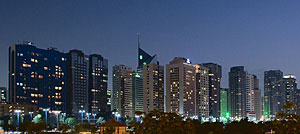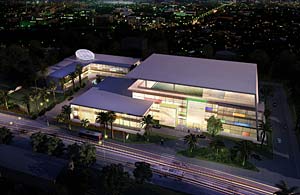Only about 125 miles separate Dubai and Abu Dhabi, but the Persian Gulf emirates can seem worlds apart in terms of opportunities for architects.
In Dubai, unfinished high-rises litter the horizon, as the emirate dramatically suffers the effects of the housing downturn. In January, the emirate even experienced its first foreclosure when the British-bank Barclays won a case to take back a property (details are undisclosed). More foreclosures are expected in coming weeks.


FIRMS IN ABU DHABI
Here are some firms that have opened an Abu Dhabi office or plan to this year.
Benoy
Carol R. Johnson Associates
Design World Partnership
FXFowle
Gensler
HKS
Kohn Pedersen Fox Associates
Leo A Daly
Perkins Eastman
Rafael Viñoly Architects
Solomon Cordwell Buenz
Otak International
But in Abu Dhabi, office buildings, homes, and even airports continue to be planned and built, as the city pushes beyond its borders to encompass former desert lands and tidal flats. Architects from overseas seem to be betting that the growth spurt will continue, as about a dozen firms from the U.S. and elsewhere, including HKS, FXFowle, and Leo A Daly, have opened offices there.
“It can feel a bit like the California Gold Rush,” says Ross Ensor, a vice president of Leo A Daly, the Omaha-based architectural firm, whose Abu Dhabi office opened in January. Around the same time, Daly was completing a design for an Abu Dhabi outpost of the New England Center for Children, which will occupy a flat-roofed 118,000-square-foot complex whose walls feature colored-glass panels.
Because Abu Dhabi’s economy relies on oil, and not tourism like Dubai, it is inherently more stable, says Ensor, adding that “the price of a barrel of oil would have to drop considerably for a major period of time to have any impact.”
And because those oil revenues flow mostly to the government, which finances the bulk of Abu Dhabi’s development projects, those projects have relatively strong financial backing, says architect Paul Katz, president of Kohn Pedersen Fox Associates (KPF).
The New York-based firm, whose Abu Dhabi office was something of a pioneer, opening in the 1990s, recently designed the Midfield Terminal Complex, a new 45-gate facility that will almost double the size of the emirate’s airport, built in the early 1980s. At 6.42 million square feet, it will also make the Abu Dhabi International Airport one of the world’s largest airports, up there with Hong Kong’s and Singapore’s.
Although design revisions have pushed back the facility’s opening from 2012 to 2015, according to KPF, construction is under way. “If it involves a government contract, it will probably happen,” says Katz about the likelihood of his Abu Dhabi projects and others being built.
Even though it’s not a separate country, Abu Dhabi requires foreign architects to set up a physical office there as part of the unusually arduous licensing process, which can take up to eight months, architects say.
But an onsite presence can also benefit client relations, explains architect Ted Strand, a principal with Solomon Cordwell Buenz (SCB). The firm, which has offices in Chicago and San Francisco, opened an Abu Dhabi branch in March 2009.
“These are hugely demanding clients. They want to feel that you are committing to them,” says Strand, who is currently creating is a master plan for Capital City Center, a mixed-use community on a 2,400-acre plot on the outskirts of the existing metropolitan area. The new neighborhood is intended to house 200,000 people.
Yet the cost of maintaining an overseas office can be “overwhelming” for a small firm, says architect Michael Kostow, a principal in the 15-employee Kostow Greenwood, whose sole office continues to be in Manhattan. The firm, whose specialty is designing television studios, is subcontracting with KPF for the new headquarters of the Abu Dhabi Media Company. Still, it doesn’t plan to open an office in the emirate anytime soon.
Working in Abu Dhabi does present challenges. Housing is pricey, which means many foreign architects working there are forced to commute from Dubai, where rents are lower on account of the downturn.
And despite few obvious signs of struggles, some projects have stumbled, says Jonathan Stark, a managing director of Perkins Eastman International, which will open an office in Abu Dhabi this year. Indeed, in recent months, Stark explains, a mixed-use community designed by his firm was postponed, and an international school project was nixed entirely.
Yet delays in Abu Dhabi tend to be temporary, says Bill Taylor, a principal with Carol R. Johnson Associates, a Boston-based landscape-design firm. Its highest-profile commission is Central Park, a 25-acre swath of canals, parks and shops that anchors the Shams City housing development.
Besides, steep housing prices indicate that more units are needed, says Taylor, which may bode well for future projects: “There’s pent-up demand that hasn’t been met yet.”

Post a comment to this article
Report Abusive Comment